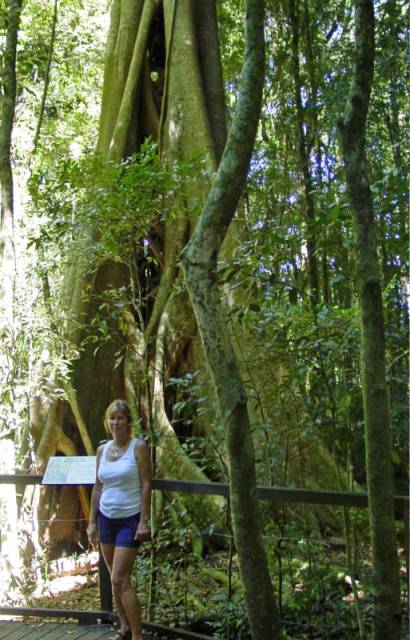|
AUSTRALIA |
 |
|
Queensland - AUSTRALIAN ZOO & Tour through the RAIN FOREST |
 |
A Multi Talent As we were leaving the Park, we stopped to enjoy some local entertainment. This musician was playing almost every instrument you could image, including the native didgeridoo. He would pick his guitar, while tapping a percussion instrument with his foot, while blowing on a sax or didgeridoo, all at once! We bought one of his CD's because his music was so uncommon. |
The Glass House Mountains Heading back to Manly, we took the Glass House Mountain Tourist Drive, detouring to several scenic lookouts that offered panoramic views of the curious group of crags rising up from the coastal plane. These mountains were named by Lieutenant James Cook who thought the mountains resembled the glass furnaces from his hometown in Yorkshire, England.
The Glass Mountains were once actually lava plugs within volcanic cones. These volcanic cones and surrounding sandstone were eroded by the wind and water over 25 million years to reveal the lava plugs which can be seen today. There are 14 mountains spread over over 600,000 hectares. Mt Beerwah is the highest of the group - 556 m. |
|
| The landscape through the Parkland was lush with forests of gum trees opening up to fields of planted pineapple and green pastures. That evening we were rewarded by a pink and orange sky to end a perfect day. |
April 4, 2006 Blackall Range After the folks left to go home to Canada, Gord and I returned to the Hinterland Region where we continued on past Landsborough and through the Blackall Range. This segment of the journal is out of chronological date range but I am including it because of the massive views of the Blue Mountains that we encountered from the The Mary Caincross Scenic Reserve. |
||
 |
Tranquil Pastures The scenery through the Range was very pastoral and consisted of gentle rolling green hills, dotted with trees and pockets of rainforests. |
 |
 |
Lakes and Waterfalls We drove to Lake Baroon, near Montville along the Razorback, which offered great coastal and lake views. There were lots of walking trails in the area, most of which ended up at a waterfall. We had to be careful as we were warned of snakes all through the area and we only had flip flops on. |
 |
 |
The Reserve is a living museum of diverse plants and animals in what remains of the once vast sub tropical Rainforest, many of these species are rare and threatened. Among the 100 tree species found, The Strangler Fig (left) grows to an enormous size as it eventually chokes its host support tree. |
The Dense Rainforest |
Beside the numerous varieties of Gum Trees, (Scibbly, Blue, Spotted) there are Beech Trees with their smooth bark, the Paper Bark Trees with their shaggy trunks, Red Cedars, Palm Groves and others trees that have adapted to wetland areas. The most curious is the Wonga Vine that seems to be wrapped around everything! | ||
 |
|||||
 |
The forests were profuse with Epiphytes, the Staghorn Ferns and Crows Nest Ferns being the most prevalent clinging to what available space there was on almost every tree trunk, | Put a Peg on Your Hooter! I heard this expression from one of the Ozzies and it was good advice as we continually kept smelling a very offensive odour that at first we thought was a Skunk. But we were sure that there were no skunk in Australia and so inquired. We found out that the culprit was Stinking Roger, a seasonal plant the releases the stench. |
 |
| We left the Blackall Range and headed from the charming village of Mapleton to the surfer coastal town of Maroochydore. Maroochydore is situated on a River inlet but the ocean surf is just minutes away. We spent the night in a cabin at a Caravan Park surrounded by trees chock full of thousands of screeching parrots gathering to roost. It was quite a sight! (and sound)! |
 |
From Noosa we traveled inland and somehow ended up on a 4x4 trail that short-cutted across to Tin Can Bay along about a 25 km bright red, bumpy sandy road. We decided that the "outback" of Australia was likely this color. The landscape had changed from lush to scrub and the area was definitely home to the blue collar or perhaps the aborigine sector of the population. |
 |
| There wasn't much at Tin Can Bay, so we ventured on to Rainbow Beach where the colored sands are supposed to be impressive. However, although the beach was nice, we didn't think a strip of black in the sand intermingled with the white constituted anything really impressive. There were cliffs in the distance but these were only accessible by 4 wheel drive vehicles on the beach. Perhaps that was where the attraction was. |
| As it was getting late we headed back toward the Bruce Highway and drove back to the boat in about 3 hours. |







